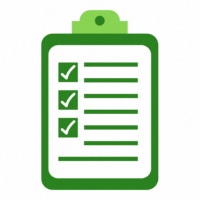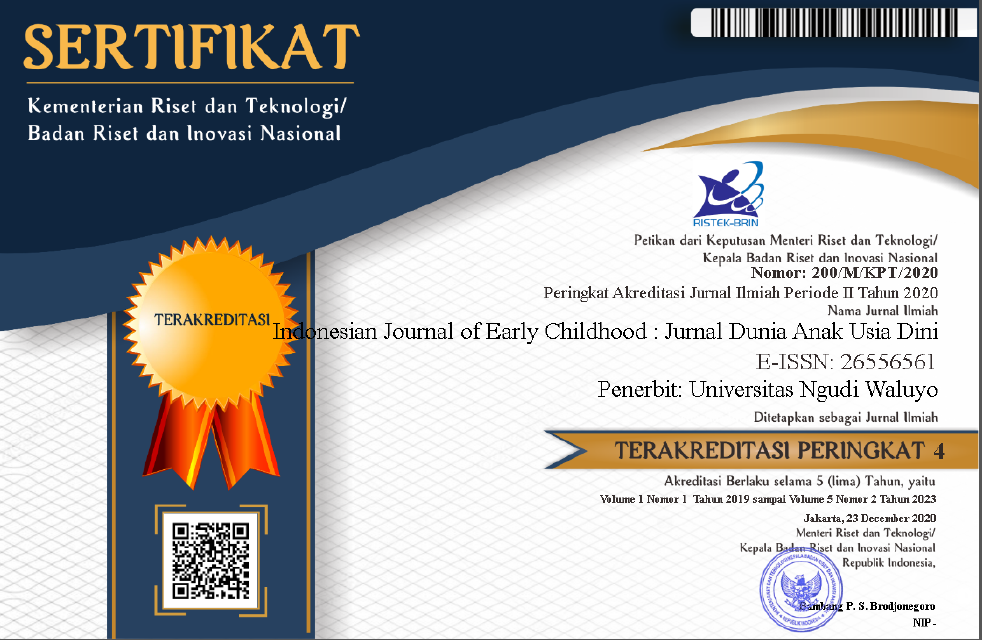Penerapan Permainan Halang Rintang untuk Meningkatkan Kemampuan Motorik Kasar Anak Usia 4- 5 (Kelompok A) Tahun di TK Hom Pim Pa
Implementation of Obstacle Games to Improve The Gross Motor Ability of Children Aged 4-5 (Group A) Years at Hom Pim Pa Kindergarten
DOI:
https://doi.org/10.35473/ijec.v7i1.2821Abstract
handling as early as possible. Gross motor development in children is a very important aspect of development. Obstacles are an activity that develops children's gross motor skills. Obstacles or hurdles develop a sense of balance in children. This research is based on a classroom action research approach. This research was conducted from October to November 2023. The aim of this research is to properly develop children's gross motor aspects such as eye and body movement coordination at HOM PIM PA Kindergarten and reduce children's frequent falls when running or walking. The results of the study showed that with the expected development norms, children's gross motor development increased, previously in the pre-cycle, there were 6 children (43%) who began to be able to carry out gross motor movements in an organized and balanced manner, then on the first day of action in cycle I, the average percentage was obtained. 13 children's gross motor development (93%) began to develop at the gross motor stage. Then, in the second cycle of action on the second day, 11 (78.6%) of the children's gross motoric development was found to be developing according to expectations and could do it themselves without help. It can be concluded that the obstacle game can improve the gross motoric development of group A2 at HOM PIM PA Kindergarten.
ABSTRAK
Pendidikan anak usia dini merupakan masa kritis dan hal penting yang sangat memerlukan perhatian dan penanganan sedini mungkin. Perkembangan motorik kasar pada anak merupakan aspek perkembangan yang sangat penting. Rintangan merupakan salah satu kegiatan yang mengembangkan kemampuan motorik kasar anak. halang rintang atau rintangan mengembangkan rasa keseimbangan pada anak-anak. Penelitian ini didasarkan pada pendekatan penelitian tindakan kelas. Penelitian ini dilakukan pada bulan Oktober hingga November 2023.Tujuan dari penelitian ini adalah untuk mengembangkan dengan baik aspek motorik kasar anak seperti koordinasi gerak mata dan tubuh di TK HOM PIM PA dan mengurangi anak sering terjatuh saat berlari atau berjalan. Hasil penelitian menunjukkan bahwa dengan norma perkembangan yang diharapkan, perkembangan motorik kasar anak meningkat yang sebelumnya pada prasiklus yaitu terdapat 6 anak(43%) yang mulai dapat melakukan Gerakan motorik kasar dengan terorganisis dan seimbang, lalu hari pertama tindakan siklus I didapat presentase rata-rata perkembangan motorik kasar anak sebanyak 13 anak(93%) mulai berembang pada tahap motoric kasar. kemudian pada tindakan siklus II di hari kedua didapat perkembangan motorik kasar anak sebanyak 11(78,6%) anak berkembang sesuai harapan dan bisa melakukan sendiri tanpa bantuan.Dapat disimpulkan bahwa permainan rintangan dapat meningkatkan perkembangan motorik kasar kelompok A2 di TK HOM PIM PA.
References
Arif, Ahmad Zaenal, and Siti Nurrochmah. 2021. “Study of Locomotor Movement Ability.” Seminar Nasional Pendidikan Jasmani Dan KesehatanProsiding Seminar Nasinoal “Peran Sport Science Pada Masa Pandemi Covid-19,” 27–40.
Audina, Syafura, and Panggung Sutapa. 2020. “Permainan Halang Rintang Untuk Meningkatkan Motorik Kasar Pada Anak Usia Dini Yang Mengalami Obesitas.” Jurnal Pendidikan Anak 6 (1): 30–37. https://doi.org/10.23960/jpa.v6n1.20864.
Baan, Addriana Bulu, Hendriana Sri Rejeki, and Nurhayati. 2020. “Perkembangan Motorik Kasar Anak Usia Dini.” Jurnal Bungamputi 6 (0): 14–21.
Multahada, Asyruni, Pingky Melaty, Heni Apriyani, and Tris Andriani. 2022. “PRIMEARLY Jurnal Kajian Pendidikan Dasar Dan Anak Usia Dini PENGEMBANGAN MOTORIK KASAR ANAK USIA DINI MELALUI PERMAINAN KREATIF Pingky Melaty Tris Andriani.” Kajian Pendidikan Dasar Dan Anak Usia Dini 5 (April): 11–21.
Muslihin, Heri Yusuf. 2020. “Bagaimana Mengajarkan Gerak Lokomotor Pada Anak Usia Dini?” Jurnal Paud Agapedia 2 (1): 76–88. https://doi.org/10.17509/jpa.v2i1.24390.
Oktadinata, Alek, and Hendri Munar. 2019. “Sosialisasi Manfaat Keterampilan Motorik Kasar Terhadap Perkembangan Kognitif, Afektif, Dan Psikomotor.” Cerdas Sifa Pendidikan 1 (2): 76–82.
Permana, Dhias Fajar Widya. 2013. “Perkembangan Keseimbangan Pada Anak Usia 7 s/d 12 Tahun Ditinjau Dari Jenis Kelamin.” Media Ilmu Keolahragaan Indonesia 3 (1): 25–29. https://journal.unnes.ac.id/nju/index.php/miki/article/view/2657.
Rahayu, Suprapti. 2013. “Aktivitas Bermain Halang Rintang Untuk Meningkatkan Kemampuan Motorik Kasar Anak Kelompok B Tk Salsabilah Surabaya.” PAUD Teratai 2 (1): 1–9.
Sari, Dewi Nilam. 2020. “An Analysis of the Impact of the Use of Gadget on Children’s Language and Social Development” 449 (Icece 2019): 201–4. https://doi.org/10.2991/assehr.k.200715.041.
Udil, Patrisius Afrisno. 2021. “Pelatihan Penulisan Artikel Ilmiah Penelitian Tindakan Kelas Untuk Publikasi Pada Jurnal IIlmiah.” Jurnal Nasional Pengabdian Masyarakat 2 (1): 21–27. https://doi.org/10.47747/pengabdiankepadamasyarakat.v2i1.257.
Utari, Ella Ramadani Ritonga, Hariyanti, Lutfiah Aini, Wahyuni, and Khadijah. 2022. “Meningkatkan Kemampuan Motorik Kasar Anak Usia Dini Melalui Permainan Engklek.” CERDAS - Jurnal Pendidikan 1 (2): 52–60. https://doi.org/10.58794/cerdas.v1i2.208.
Downloads
Published
How to Cite
Issue
Section
License
Copyright (c) 2025 Indonesian Journal of Early Childhood: Jurnal Dunia Anak Usia Dini

This work is licensed under a Creative Commons Attribution-ShareAlike 4.0 International License.
Please find the rights and licenses in Indonesian Journal Of Early Childhood: Jurnal Dunia Anak Usia DIni. By submitting the article/manuscript of the article, the author(s) agree with this policy. No specific document sign-off is required.
1. License
The non-commercial use of the article will be governed by the Creative Commons Attribution license as currently displayed on Creative Commons Attribution-ShareAlike 4.0 International License.
2. Author(s)' Warranties
The author warrants that the article is original, written by stated author(s), has not been published before, contains no unlawful statements, does not infringe the rights of others, is subject to copyright that is vested exclusively in the author and free of any third party rights, and that any necessary written permissions to quote from other sources have been obtained by the author(s).
3. User Rights
Indonesian Journal Of Early Childhood: Jurnal Dunia Anak Usia Dini's spirit is to disseminate articles published are as free as possible. Under the Creative Commons license, Indonesian Journal Of Early Childhood: Jurnal Dunia Anak Usia Dini permits users to copy, distribute, display, and perform the work for non-commercial purposes only. Users will also need to attribute authors and Indonesian Journal Of Early Childhood: Jurnal Dunia Anak Usia Dini on distributing works in the journal and other media of publications.
4. Co-Authorship
If the article was jointly prepared by more than one author, any authors submitting the manuscript warrants that he/she has been authorized by all co-authors to be agreed on this copyright and license notice (agreement) on their behalf, and agrees to inform his/her co-authors of the terms of this policy. Indonesian Journal Of Early Childhood: Jurnal Dunia Anak Usia Dini will not be held liable for anything that may arise due to the author(s) internal dispute. Indonesian Journal Of Early Childhood: Jurnal Dunia Anak Usia Dini will only communicate with the corresponding author.
5. Miscellaneous
Indonesian Journal Of Early Childhood: Jurnal Dunia Anak Usia Dini will publish the article (or have it published) in the journal if the article’s editorial process is successfully completed. Indonesian Journal Of Early Childhood: Jurnal Dunia Anak Usia Dini's editors may modify the article to a style of punctuation, spelling, capitalization, referencing and usage that deems appropriate. The author acknowledges that the article may be published so that it will be publicly accessible and such access will be free of charge for the readers as mentioned in point 3.
Â
Every accepted manuscript should be accompanied by "Copyright Transfer Agreement" prior to the article publication.



